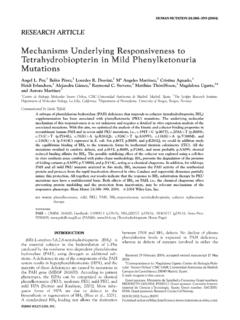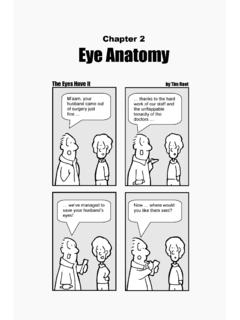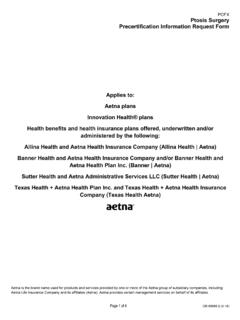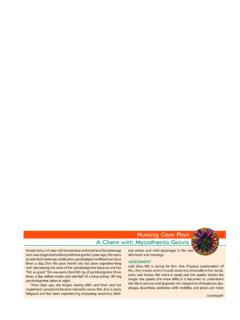Transcription of www.biopku.org
1 2 Disorders of Neurotransmitter Metabolism Keith Hyland Introduction This chapter will focus on primary disorders of serotonin and catechol- amine (biogenic amine) metabolism and the defect affecting the glycine re- ceptor (hyperekplexia). Secondary disorders of biogenic amine metabolism are described elsewhere (disorders , , , , , , ). n Disorders of Serotonin and Catecholamine Metabolism Described defects in biogenic amine metabolism include deficiencies of ty- rosine hydroxylase (TH) (EC ) [1, 2], aromatic L-amino acid decar- boxylase (AADC) (EC ) [3], dopamine b-hydroxylase (DbH) (EC. ) [4, 5] and monoamine oxidase (MAO) (EC ). MAO defi- ciency has been described as an isolated defect of MAO-A [6] and as a de- ficiency of either MAO-A or MAO-B, or both, in association with Norrie disease [7].
2 Inheritance in all of these disorders is thought to be autosomal recessive. There is clear biochemical and clinical heterogeneity between these con- ditions, but the small number of reported cases precludes an accurate as- certainment of intra-disease heterogeneity. Lack of TH leads to a specific deficit of the catecholamines (dopamine, norepinephrine and adrenaline). AADC is required for the synthesis of the catecholamines and serotonin. Lack of this enzyme therefore causes a global deficiency of all of these neu- rotransmitters as is found in the abnormalities of tetrahydrobiopterin meta- bolism (Chap. 1). The clinical symptoms are also similar, including devel- opmental delay, central and peripheral hypotonia, temperature instability, chorea, ptosis and oculogyric crises.
3 The two conditions are in general dis- tinguishable as hyperphenylalaninemia is not present in AADC deficiency. However, certain forms of tetrahydrobiopterin deficiency also do not pre- sent with hyperphenylalaninemia. Deficiency of DbH results in an inability to synthesize norepinephrine from dopamine. The disease has only been described in adults and the characteristic finding is a disabling orthostatic hypotension. Retrospective case histories have reported ptosis and episodic hypothermia, hypoglyce- 108 Disorders of Neurotransmitter Metabolism mia and hypotension in the neonatal period [8]. The disorder has never been recognized in infancy and it is possible, therefore, that many infants succumb to this disorder undiagnosed.
4 MAO-A and MAO-B are required for the catabolism of serotonin and the catecholamines. A large kindred with a point mutation in the structural gene for MAO-A. has been studied. The disease is X linked and affected males have border- line mental retardation and exhibit abnormal behavior, including disturbed regulation of impulsive aggression [6]. Five patients with X chromosomal deletions, including MAO-A and MAO-B as well as the Norrie disease gene, had severe mental retardation [7], whilst two brothers with a complex dele- tion involving the Norrie disease gene and part of the MAO-B structural gene but with an intact MAO-A gene had no psychiatric symptoms or men- tal retardation [9].
5 The involvement of deletions of the X chromosome in areas other than the structural genes for MAO-A and MAO-B make inter- pretation of the clinical data in these patients difficult and to date a specif- ic defect affecting only MAO-B has not been described, therefore, only the MAO-A patient will be referred to in the following review. These diseases are not detected via conventional screening methodology ( organic acids, amino acids etc.), therefore diagnosis relies on the anal- ysis of neurotransmitters and their metabolites in CSF, urine or plasma. In general, TH deficiency leads to low levels of catecholamines and their meta- bolites, AADC deficiency leads to decreased concentrations of catechol- amines, serotonin and their metabolites.
6 In AADC deficiency there is also an accumulation of neurotransmitter precursors, namely 5-hydroxytrypto- phan, levodopa and its methylated derivative, 3-O-methyldopa. DbH defi- ciency leads to decreased norepinephrine and an increase in dopamine, and MAO-A deficiency to an increase in the biogenic amines and their O- methylated catabolites, and to a decrease in concentration of their deami- nated catabolites. Therapy in the deficiencies of TH, AADC and DbH is aimed at correct- ing the neurotransmitter abnormalities. Bypassing the metabolic block using levodopa/carbidopa together with dopamine agonists has led to im- provement in TH deficiency [10].
7 Monoamine oxidase inhibitors, in con- junction with dopamine agonists and vitamin B6 (cofactor for AADC) ame- liorated symptoms in AADC deficiency [3] and dihydroxyphenylserine (DOPS decarboxylated to form norepinephrine) has corrected the norepi- nephrine deficiency in DbH deficiency [8]. Currently a therapy for MAO-A. deficiency has not been described. Nomenclature 109. n Glycine Receptor Defects (Hyperekplexia). Hyperekplexia (or familial startle disease) is characterized by extreme gen- eralized stiffness after birth (stiff baby syndrome), exaggerated startle re- sponse, continuing hypertonia during infancy and a transient increase in tone following startle attacks [11].
8 In some families the disease is asso- ciated with spastic paraparesis. Many cases of hyperekplexia are caused by mutations in the a1 subunit of the glycine receptor (GLRA1) gene [12]. There are likely also to be other causes as cases have been described where mutations in the GLRA1 gene have not been found [13]. The disease can be inherited in either an autosomal dominant or recessive manner. As all biochemical testing is generally negative, diagnosis has to be ini- tially made on clinical grounds. In the severe neonatal form of hyperek- plexia, stiff baby syndrome' abrupt stimuli leads to a dramatic startle re- flex followed by a sustained tonic spasm.
9 Apnoea may occur leading to sud- den infant death syndrome (SIDS). Hyperekplexia should be considered where there is hyperexcitability, episodes of muscle rigidity, apnoea, aspira- tion pneumonia or near miss SIDS. In later life, the mainstay in diagnosis is the observation of an episode following abrupt stimuli. An episode con- sists of startle, followed by hands dropping to the sides and unprotected falling. Consciousness is preserved (unless there is head trauma) and there is usually no evidence for EEG abnormality. Definitive diagnosis is accom- plished by the finding of mutations in the GLRA1 gene. Treatment at all ages is with clonazepam.
10 Nomenclature No. Disorder-affected Tissue distribution Chromosomal McKusick component localisation Tyrosine hydroxylase Brain, kidney 191290. deficiency Aromatic L-amino Brain, liver, kidney, 107930. acid decarboxylase peripheral neurons (AADC) deficiency Dopamine b-hydroxy- Brain, peripheral 9q34 223360. lase (DbH) deficiency neurons Monoamine oxidase Ubiquitous Xp11 p21 region 307850. (MAO)-A deficiency Hyperekplexia, gly- Brain 5q33 q35 149400. cine receptor defect 110 Disorders of Neurotransmitter Metabolism Metabolic Pathway Epinephrine Norepinephrine Normetanephrine MHPG. MET VMA. VLA. 3MT HVA. 3 OMD. Tyrosine L-DOPA Dopamine DOPAC. Tryptophan 5 HTP Serotonin 5 HIAA.









